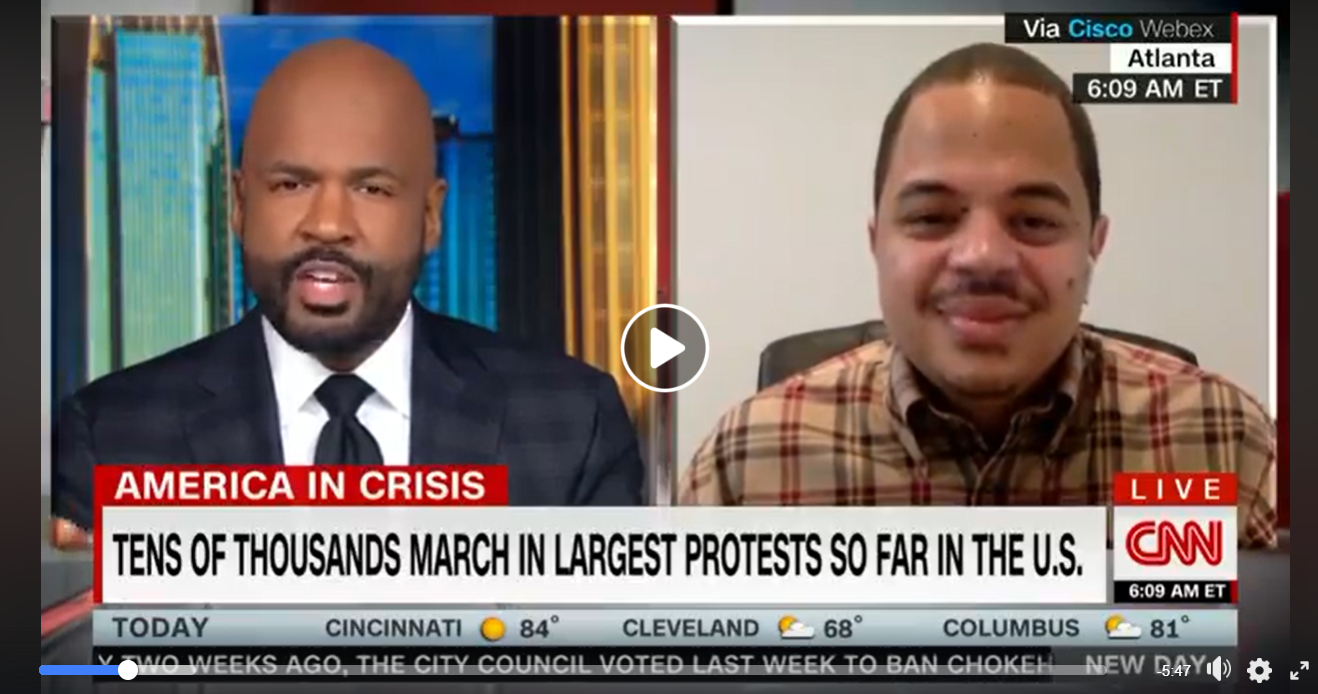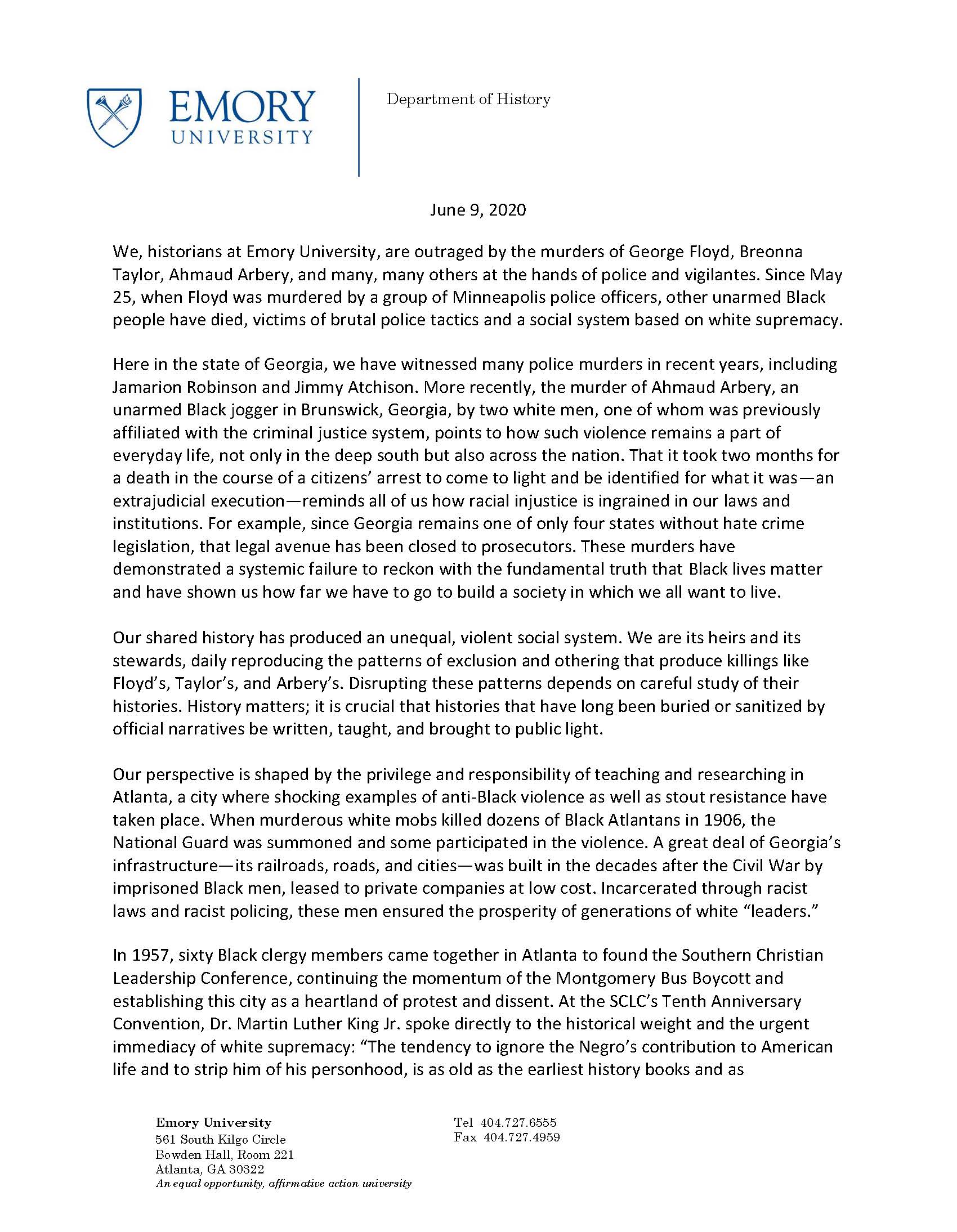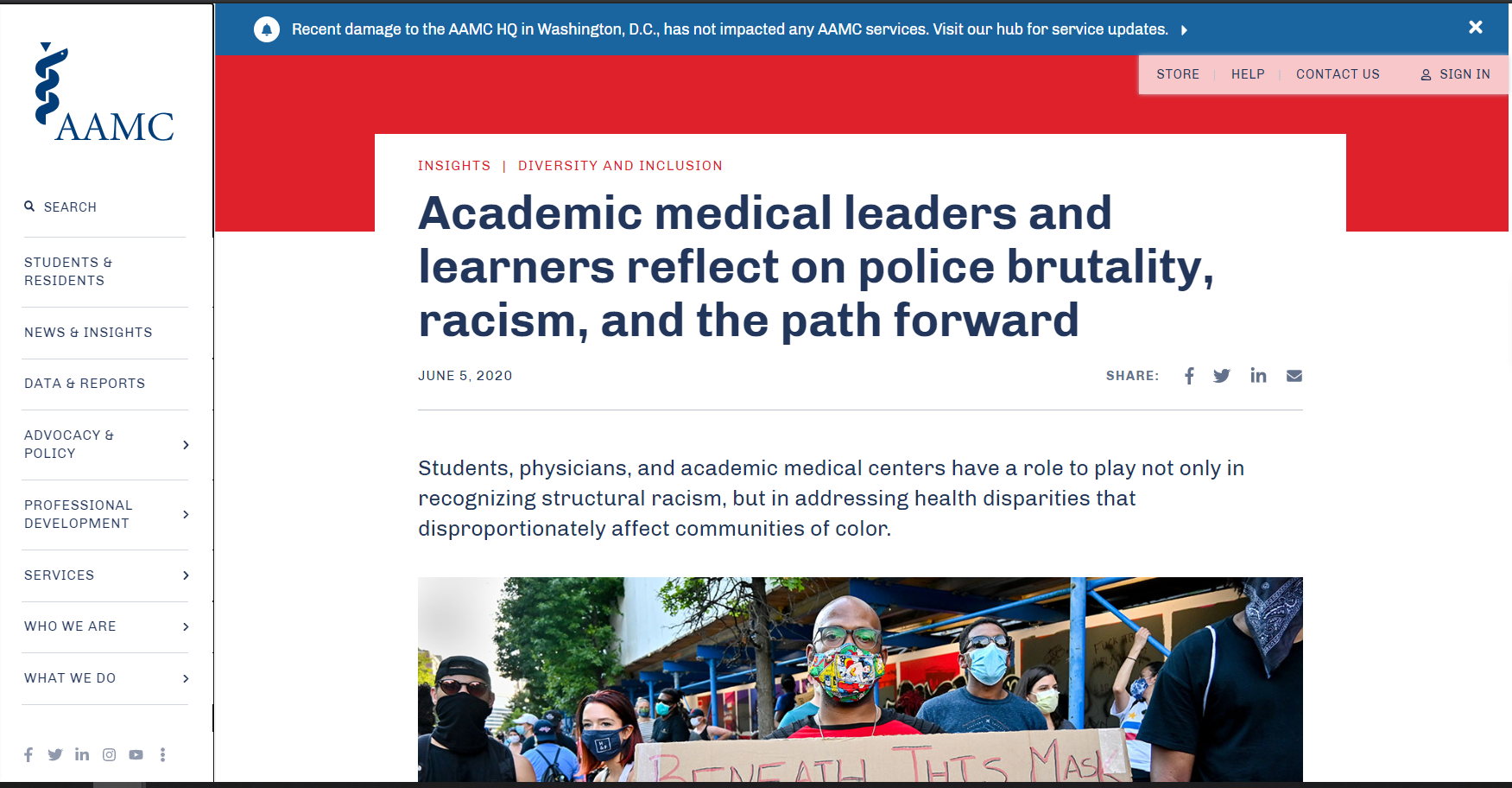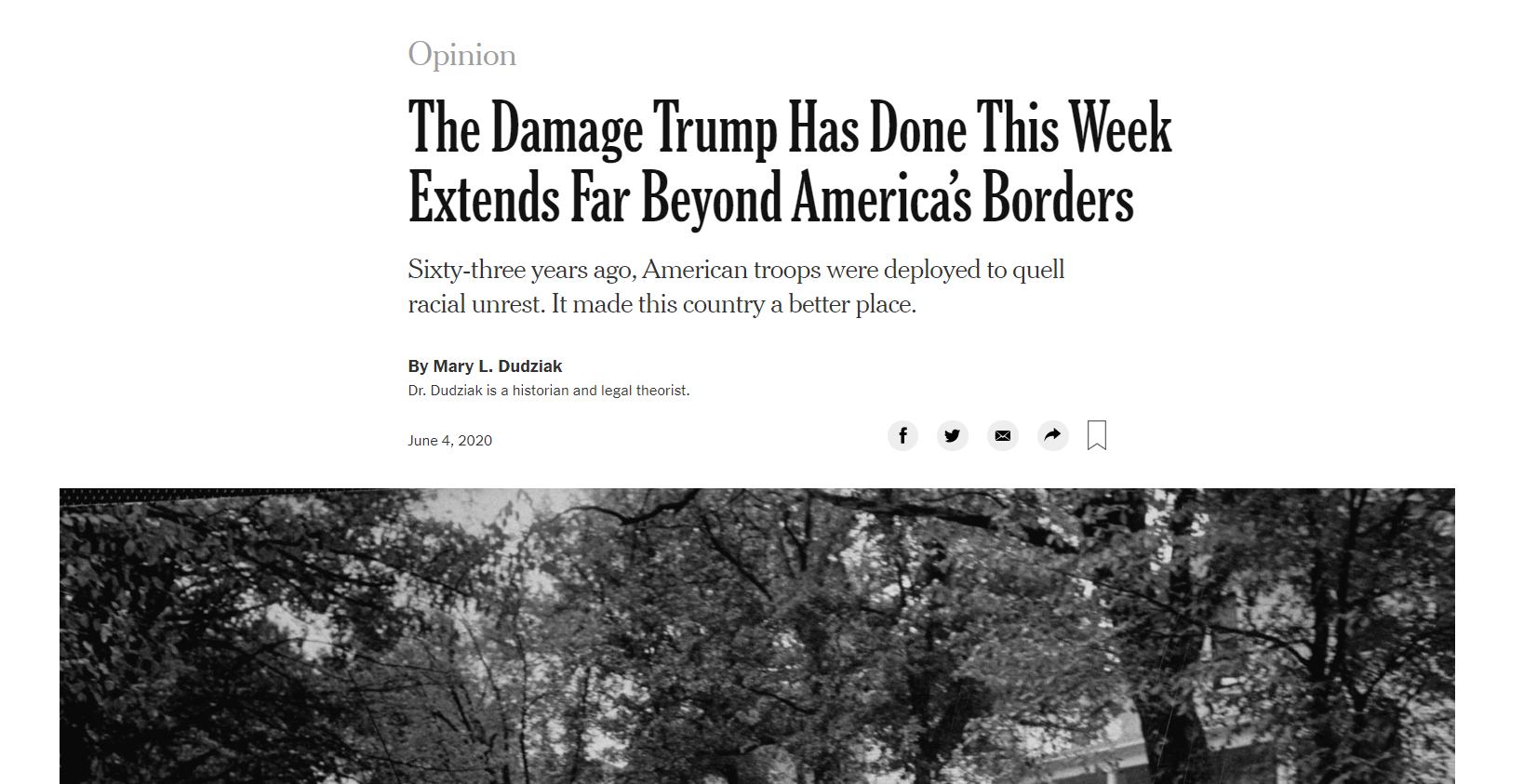Assistant Professor Chris Suh has won the W. Turrentine Jackson (Article) Prize of the Pacific Coast Branch, American Historical Association for an article he published in Pacific Historical Review last year. Titled “‘America’s Gunpowder Women’: Pearl S. Buck and the Struggle for American Feminism, 1937-1941,” the piece examines debates between first and second wave feminism and the influence of racialized thinking on U.S. conceptions of women’s progress. The prize is sponsored by the University of California Press.
Month / June 2020
History Major Nayive Gaytán Among Newest Institute for Recruitment of Teachers Fellows
Congratulations to Emory History major Nayive Gaytán, who has been accepted in the Institute for Recruitment of Teachers‘ 2020/2021 cohort. The IRT supports “talented underserved and underrepresented students, students of color, and students who are committed to issues of social justice, diversity, and equity in education” throughout the graduate school application process. Nayive will be applying to PhD programs in History and Spanish this year.
Anderson Discusses GA’s Primary Voting Issues on ‘All Things Considered’
NPR’s Ari Shapiro recently interviewed Dr. Carol Anderson, Charles Howard Candler Professor of African American Studies and Associated Faculty in the History Department, on All Things Considered. Anderson, whose most recent book is One Person, No Vote: How Voter Suppression is Destroying Our Democracy (Bloomsbury, 2018), discusses the problems that Georgia voters faced during this past Tuesday’s primary. Listen to the piece: “The Reasons Behind Voting Issues in Georgia.”
A Conversation with Danielle Wiggins (PhD, 2018) at Caltech
Dr. Danielle Wiggins (PhD, 2018), Assistant Professor of History at Caltech, was recently interviewed by the Caltech media team about her research and teaching along with politics in the U.S. today. Her PhD work centered on the politics of law and order in Atlanta in the 1970s-’80s. The dissertation was shaped by the shifting national context of the Black Lives Matter era and illuminates the political and urban history of Black politics in Atlanta. Read the full interview: “A Conversation with Danielle Wiggins.”
New Books Series: Q&A with Pablo Palomino
Dr. Pablo Palomino, Assistant Professor of Latin American & Caribbean Studies and Mellon Faculty Fellow at Emory Oxford, recently published The Invention of Latin American Music: a Transnational History with Oxford University Press. Below, Dr. Palomino offers a glimpse into the making of the monograph as a part of the History Department’s series on new faculty publications.
Books are produced over years if not decades. Give us a sense for the lifespan of this book, from initial idea to final edits.
Back in 2006 in my hometown, Buenos Aires, I decided to expand over Latin America as a whole the structural affinities between Buenos Aires’ tango and Rio de Janeiro’s samba—their poetic and social similarities—I had explored in my History thesis at the University of Buenos Aires. I was assistant professor of Latin American Social History (guided by the wonderful Dora Barrancos) and wanted to write a history of the modernization of urban music poetics in Latin America in the 1930s. I then learned that the story of marginal musical genres becoming modern national symbols at some point in the early 20th century was quite universal. What were the peculiarities of Latin America in this regard?
I suspected that the popularity of certain music genres had to do with their ability to express the experience of modernity, which is one of loss and fracture but also of re-creation of social relations and emotional bonds. (Hence the global prominence of love songs). As ethnomusicologists and many historians of music teach us, is a crucial arena for people to make sense of all that. But while the historiographic agenda was then focused on the making of national identities, somehow seeing music as mainly serving the national experiment, I was interested in the larger cultural mechanisms that made possible for people to express the experience of modern life, including but surpassing the nation. The need for an inter- or trans-national approach was evident. The peripatetic trajectories of many of my favorite artists—from Carlos Gardel to Caetano Veloso—also suggested this approach, as it was the music repertoire of my parents’ generation, made of several chronological layers and geographic spaces: my folks, Argentine baby-boomers, and their Chilean or Bolivian friends, can sing by heart entire Cuban boleros and Mexican rancheras from the times of their parents’ generation. How does a love song from another time and space becomes part of someone’s sentimental world? And what’s the significance of this phenomenon for Latin American history? I decided to write a doctoral dissertation about how certain social and cultural elements of music—nightlife, poetics, markets, and symbols—became modernizing agents, mechanisms to process and transmit modernity, within but especially across Latin American societies in the 20th century.
With that idea in mind I moved to California, thanks to a scholarship from UC Berkeley, and from 2007 to 2014, under the guidance of Mark Healey, Margaret Chowning, and awesome fellow students, I realized that the key concept of my research would be that of transnational musical networks, which involved not just “genres,” but diasporic artists, musicians’ associations, broadcasting, impresarios, cultural diplomacy, and musicology itself, which emerged in Latin America in the 1930s. I remember discovering at the Bancroft Library the volumes of the pioneering Latin Americanist musicological flagship, the Latin American Music Bulletin (1934-1946), and realizing something incredibly obvious and yet overlooked by scholars: that the very category of “Latin American music” had a history! The dissertation analyzes several musical networks connecting Latin America through archival work in the region’s three largest countries (Brazil, Mexico, and Argentina, plus the United States).
Then in 2015-2017, as a postdoc at the University of Chicago, I realized that my project could illuminate something bigger: that music was arguably the most romantic—in the exoticist and essentialist sense—dimension of the very idea of Latin America that has been naturalized by scholars in their intellectual practice and by lay people in the public sphere. Inspired by Mauricio Tenorio’s critique of “Latin Americanism” as a discourse, I began to re-write some chapters and add new ones, in order to show how those transnational networks in fact had produced the very musical idea of Latin America, and also that they were key in turning the abstract 19th-century idea of “Latin America,” into a legitimate world region—in Herder’s terms, if it has a music, then it’s a culture, and therefore a people.
Since I began working at Oxford College of Emory in 2017, I elaborated these insights, gained tons of feedback in conferences and presentations, and finished the writing in a very supportive environment—and the OUP editors and reviewers gave me precious feedback. My students help me see in the classroom that what we call “Latin America” is at the same time a mosaic of widely disparate histories and the subject of a cultural transmission that has itself a long history—one to which I am happy to contribute.
What was the research process like?
It was wonderful, in that it took me through multiple archives, languages, and disciplines. Starting with the Inter-Library Loan system, which is one of the most wonderful things ever created and gave me access to a truly global perspective on music, modernity, and globalization. Then the CLIR-Mellon and the SSRC fellowships, as well as support from UC Berkeley, allowed me to spend a lot of time in Belo Horizonte (Brazil), Mexico City, Berlin, Buenos Aires, and Washington DC, tracing key archival threads. I ended up using only a fraction of the material I gathered, but also published along the way some side articles on specific histories. The research journey combined archives with fascinating places, people, and ideas. Then organizing the sources and writing the book was like continuing to travel through those places, people, and ideas from my own desk at home or my office.
Are you partial to a particular chapter or section?
There is a section in the Introduction that I added toward the end of the writing process, in which I chronologically reconstruct the elaboration of the idea of “Latin America” since colonial times, in order to locate the emergence of Latin American music in the early 1930s as a way of defining this world region. This is perhaps my most important historiographic contribution. I was undecided about the title of this introductory chapter: should “Music” and “Latin American History” be connected with“and” or with“in”? Then Jeffrey Lesser suggested the exact title, which he saw hidden in plain sight: “Music is Latin American History”—it captures the whole point of the book.
How does this project align with your broad research agenda?
My research focuses on history in three ways. As a problem, I’m fascinated by the history of globalization—and this book tells the history of musical globalization from a regional perspective. As a method, I am inspired by the “total history” of the medievalists from the Annales school that sought the articulation of the multiple dimensions (cultural, political, mental, economic, environmental, etc.) of human reality. I did an absolutely modest attempt in my book to study aesthetic, economic, cultural, and political dynamics combined. And as a cultural activity, I am interested in researching the history of Latin America to combat stereotypes and contribute to its regional and global integration. Somehow this book, very imperfectly, advances this general agenda.
History Department Denounces Police Violence and White Supremacy
A statement, dated June 9, 2020, from Emory historians on police violence and white supremacy:
“We, historians at Emory University, are outraged by the murders of George Floyd, Breonna Taylor, Ahmaud Arbery, and many, many others at the hands of police and vigilantes. Since May 25, when Floyd was murdered by a group of Minneapolis police officers, other unarmed Black people have died, victims of brutal police tactics and a social system based on white supremacy.
Here in the state of Georgia, we have witnessed many police murders in recent years, including Jamarion Robinson and Jimmy Atchison. More recently, the murder of Ahmaud Arbery, an unarmed Black jogger in Brunswick, Georgia, by two white men, one of whom was previously affiliated with the criminal justice system, points to how such violence remains a part of everyday life, not only in the deep south but also across the nation. That it took two months for a death in the course of a citizens’ arrest to come to light and be identified for what it was—an extrajudicial execution—reminds all of us how racial injustice is ingrained in our laws and institutions. For example, since Georgia remains one of only four states without hate crime legislation, that legal avenue has been closed to prosecutors. These murders have demonstrated a systemic failure to reckon with the fundamental truth that Black lives matter and have shown us how far we have to go to build a society in which we all want to live.
Our shared history has produced an unequal, violent social system. We are its heirs and its stewards, daily reproducing the patterns of exclusion and othering that produce killings like Floyd’s, Taylor’s, and Arbery’s. Disrupting these patterns depends on careful study of their histories. History matters; it is crucial that histories that have long been buried or sanitized by official narratives be written, taught, and brought to public light.
Our perspective is shaped by the privilege and responsibility of teaching and researching in Atlanta, a city where shocking examples of anti-Black violence as well as stout resistance have taken place. When murderous white mobs killed dozens of Black Atlantans in 1906, the National Guard was summoned and some participated in the violence. A great deal of Georgia’s infrastructure—its railroads, roads, and cities—was built in the decades after the Civil War by imprisoned Black men, leased to private companies at low cost. Incarcerated through racist laws and racist policing, these men ensured the prosperity of generations of white “leaders.”
In 1957, sixty Black clergy members came together in Atlanta to found the Southern Christian Leadership Conference, continuing the momentum of the Montgomery Bus Boycott and establishing this city as a heartland of protest and dissent. At the SCLC’s Tenth Anniversary Convention, Dr. Martin Luther King Jr. spoke directly to the historical weight and the urgent immediacy of white supremacy: “The tendency to ignore the Negro’s contribution to American life and to strip him of his personhood, is as old as the earliest history books and as contemporary as the morning’s newspaper.” Yet while Black contributions to our nation remain buried, monuments to white supremacy are still standing in the obelisks and statues erected to the “lost cause,” and a new Jim Crow is evident in unequal access to education, housing, health, and well-being.
These structures built around Black exclusion provide a model for the marginalization of other populations of color, including Georgia’s growing LatinX, immigrant, and undocumented populations. Georgia is one of four deep south states that bans undocumented students from select public institutions of higher learning. This is a painful irony given that especially in the last three decades, Georgia has become a gateway state to global refugees and migrants. History helps us to identify these processes of exclusion and the movements that have been built to resist and change them.
We recognize our obligation as historians, no matter our regional or chronological field, is to expose the racist underpinnings of our society. We also recognize that the time has come to move beyond words and the ivory tower. We must take concrete actions in the multiple ways available to us as citizens of the world to promote racial justice and equality in our wider communities. This is a shared task with our students, staff, and colleagues, one critically informed by a clear, unflinching engagement with history. We commit to strengthening our curriculum around these imperatives and to creating spaces of inclusion at our institution. We also pledge to support programming that builds community, highlights social inequities, and identifies concrete steps forward. Though our student body is increasingly diverse, Emory remains a predominantly white institution. We commit to opening paths for Black students, faculty, staff, and workers.
For resources on Emory’s campus:
Emory Office for Racial and Cultural Engagement http://race.emory.edu/
James Weldon Johnson Institute for the Study of Race and Difference http://jamesweldonjohnson.emory.edu/home/
Office of Diversity, Equity, and Inclusion http://equityandinclusion.emory.edu/
Walter L. Adamson
Patrick N. Allitt
Kathryn Amdur
Tonio Andrade
Michelle Armstrong-Partida
Susan Youngblood Ashmore
Thomas S. Burns
Adriana Chira
Clifton Crais
Joseph Crespino
Leroy Davis, Jr.
Deborah Dinner
Mary Dudziak
Astrid M. Eckert
Alison Collis Greene
Judith Evans-Grubbs
Eric L. Goldstein
Elizabeth S. Goodstein
Lakesia Hayes
Becky Herring
John T. Juricek
Daniel LaChance
Ruby Lal
Jeffrey Lesser
Kristin Mann
Roxani Margariti
James Van Horn Melton
Judith A. Miller
Maria R. Montalvo
Mary E. Odem
Gyan Pandey
Elizabeth Pastan
Cynthia Patterson
Matthew J. Payne
Jonathan Prude
James L. Roark
Thomas D. Rogers
Allison Rollins
Walter C. Rucker
Teemu Ruskola
Tehila Sasson
Ellie R. Schainker
Pamela Scully
Kylie M. Smith
Kenneth W. Stein
Karen Stolley
Sharon Strocchia
Carl Suddler
Chris Suh
Allen Tullos
Brian E. Vick
Javier Villa-Flores
Jason Morgan Ward
Katie Wilson
Yanna Yannakakis”
Click the image below to view a PDF version of the statement.
Suddler Invited to Contribute to Association of American Medical Colleges Roundtable on Racial Inequities and Medicine
The Association of American Medical Colleges invited leaders and learners in academic medicine to share their thoughts on recent events, the complicity of medicine in perpetuating inequities, and the role of students, physicians, and academic medical institutions in helping to heal the nation. Read Prof. Carl Suddler’s contribution, “Investing in health care, divesting from law enforcement” (scroll down, 10th entry).
Dudziak Publishes Op-Ed in ‘The New York Times’
Dr. Mary L. Dudziak, Asa Griggs Candler Professor of Law, published an opinion editorial in The New York Times on June 4. Dudziak’s piece is entitled “The Damage Trump Has Done This Week Extends Far Beyond America’s Borders.” Dudziak, a leading scholar of legal history in the U.S. and world, is Associated Faculty in the History Department.
Suddler Discusses Race and Police Reform, the Kerner Commission, and Abolition on CNN’s ‘New Day’
Dr. Carl Suddler recently spoke with Victor Blackwell on CNN’s New Day to discuss the history of race and police reform, the Kerner Commission, and the idea of abolition. View the interview here.

Anderson in ‘The Guardian’: “In 1919, the state failed to protect black Americans. A century later, it’s still failing”
Dr. Carol Anderson, Charles Howard Candler Professor of African American Studies and Chair of African American Studies, recently published an opinion piece in The Guardian. Anderson analyzes parallels between the wave of anti-black lynchings and race riots in 1919 – which came to be known as the “Red Summer” – and today. An associated faculty member in the Department of History, Anderson is, most recently, the author of One Person, No Vote: How Voter Suppression is Destroying Our Democracy (Bloomsbury, 2018). Read an excerpt from her timely article in The Guardian below, along with the full piece: “In 1919, the state failed to protect black Americans. A century later, it’s still failing.”
“As in 1919, we are dealing with an America where black and brown people must go into the streets to demand their rights because the institutions of democracy have failed to protect them. In 2020, we have a nation where large swaths of the executive, legislative and judicial branches at the federal and state levels have virtually abandoned millions of American citizens.”


